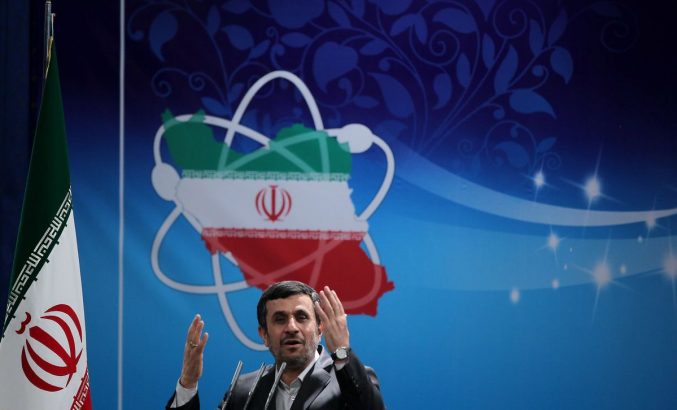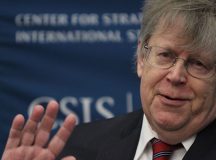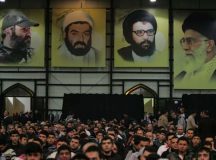The international community must now play hardball with Iran. Only escalating sanctions and a credible military threat can persuade the regime to negotiate away its nuclear programme.
Oddly enough, after a decade of ongoing (and so-far failed) international efforts to negotiate a deal with Iran that would result in it backing away from its military nuclear ambitions, the strategic issue that currently tops the agenda does not touch directly upon Iran. Rather, it has to do with issues of trust between the United States and Israel. That strained bilateral relations between these two allies are distracting attention from the urgent need to confront Iran’s nuclear ambitions is unfortunate, not least because the common ground that the US and Israel share on Iran is much more significant than any issue that divides them.
The two states see eye to eye on what Iran is striving to achieve in the nuclear realm, as well as the nature and pace of its advances; their assessments of the danger of Iran becoming a nuclear state are very similar, and both are committed to stopping this scenario from materialising. Moreover, Israel is not a player in the unfolding saga of international efforts to stop Iran; these are led by the international community with the US at the helm. The challenge of Iran’s nuclearisation is a regional and global non-proliferation concern; Israel is only one part of the overall picture, and only by virtue of its continued presence in the Middle East being threatened by Iran on a regular basis. The responsibility for upholding states’ commitments to the Nuclear Non-proliferation Treaty (NPT) lies with the UN Security Council.
And yet, in their official statements, the US and Israel are amplifying a gap in their respective approaches that could have a negative impact on the overall effort to stop Iran. Driven by its fear that Iran will attain nuclear weapons – especially against the backdrop of the horrific rhetoric that the current regime spews at Israel on a regular basis, and its frustration with the lack of success of the international efforts that it has followed somewhat impatiently from the sidelines for years – Israel has pushed itself to the forefront with talk of possible military action. Prime Minister Netanyahu and Defence Minister Barak fear that they might miss the opportunity to deal a blow to Iran’s imminent nuclear capability and that a nuclear Iran could quickly become a fait accompli. Israel views this as a major challenge to its national security.
The trust issue for Israel vis-à-vis the US is whether the latter will successfully identify in time that Iran has initiated the production of nuclear weapons, and whether it will then employ the harshest measures it has at its disposal to stop Iran. The Israeli fear is that a policy of containing a nuclear Iran is an acceptable American fallback position that lingers in the background. While President Obama is on record stating clearly that the policy of the US is that of preventing Iran from attaining nuclear weapons, the containment scenario remains stubbornly on the agenda. It appears occasionally in statements and opinions voiced by ex-officials, especially those that reportedly still advise the President from time to time.
The trust issue for the United States centres on the prospect that Israel might take matters into its own hands, and act alone, before the US has concluded that all other options have been exhausted, and that there is no alternative to military force.
The amplified bilateral disagreement is all the more troubling because in terms of its action on the ground, since early 2012, the United States has adopted a much more determined approach in confronting Iran’s nuclear activities than had been the case in previous years. In January the administration finally moved to the biting sanctions that it had threatened for several years, and it also beefed up its military presence in the Gulf, with the deployment of two aircraft carriers. When Iran threatened to close the Strait of Hormuz, the Obama administration firmly deterred Iran by clarifying that this would constitute a red line for the United States. US officials have been meeting with their Israeli counterparts and sharing information, assessments and contingency plans. Moreover, it is not only the US that has adopted a harsher approach to Iran; the EU also surprised the world in January with its decision to put in place an embargo on Iranian oil, which went into immediate effect for any new contracts, and took full effect on 1 July 2012. Britain added an important element to the sanctions regime against Iran when it barred British companies from providing insurance for tankers transporting Iranian oil.
For now, despite the failed effort to negotiate with Iran between April and June, the United States remains committed to diplomacy. The administration wants more time for its current strategy of sanctions and negotiations. Israel’s patience with diplomacy is wearing thin, however, and it is looking for clear assurances that it will not ultimately be left facing a nuclear menace, while helpless to do anything about it. If the US is absolutely serious about preventing Iran from attaining nuclear weapons, and the lack of agreement with Israel is only over the question of timing, there are most likely ways for each side to reassure the other. Finding the path to such mutual reassurances is essential for getting international efforts back on track, and enabling US energies to be directed to the task at hand – namely, turning negotiations into an effective vehicle to convince or compel Iran to change course. And this is no easy task.
Military threats are crucial for more effective negotiations with Iran
Diplomacy through negotiations is clearly the strategy of choice for dealing with Iran’s nuclear ambitions. Not only is arms control ultimately most effective when it is grounded in agreements that states have an interest in upholding, but military force at this very late stage is not a solution. In and of itself, a military campaign cannot ‘do away’ with Iran’s nuclear programme. But what is not sufficiently appreciated is that the negotiations track is the more difficult policy option. Getting Iran to come to the table in a serious manner and then carving out a mutually acceptable deal requires considerable acumen in statecraft; as the challenges and constraints to achieve such a deal are formidable.
The principal hurdle that has precluded success in these negotiations for years has yet to be seriously addressed, even though it is underscored with every day that goes by and Iran advances its programme without suffering serious consequences: there is no shared interest between the two sides in achieving a negotiated settlement. In contrast to many negotiation situations where both parties have an interest in a prospective deal, and the bargaining process then centres on the price, in negotiations with Iran, the international community is the only party interested in a deal. Currently, Iran is not similarly motivated.
The constraint inherent in this lack of symmetry between the negotiating parties is even more difficult to overcome because the international community not only wants a deal, but also is critically dependent on one to achieve its goal of ensuring that Iran backs down from its military aspirations. In its attempt to coerce Iran to back down through tough bargaining, its hand is significantly weakened by this dependence on achieving a settlement. Iran, on the other hand, is not only not dependent on a deal (and can proceed unilaterally toward its goal), but actually has strong motivations to avoid negotiating one, because such a deal would mean giving up on its long-term goal, for which it has paid a hefty price.
The difficulty presented by this structural imbalance is compounded by additional factors that work to the disadvantage of the international community in a negotiating setting. One such factor is the lack of agreement among the international players facing Iran on crucial issues that relate to Iran’s nuclear programme, as well as individual states additional economic and strategic interests that further detract from the international community’s (collective) ability to apply itself with determination, especially over time.
If the basic structural imbalance between the two sides in negotiations was recognised and addressed, this in itself could go a long way to improving the chances for more effective bargaining. The road to redressing the imbalance goes through the application of pressure on Iran. Significant pressure – through harsh economic and diplomatic sanctions and credible threats of military consequences for inaction – must be put in place in order to alter the Iranian regime’s calculation. The hardship it would experience could make the option of negotiating – with the prospect of ultimately lifting the pressure – seem more attractive than continuing towards a military capability. The ensuing negotiations would not be an exercise in engagement, but rather of tough bargaining.
Some progress was achieved in this regard over the course of 2012, and Iran came to the table in April most likely because of the impact of the biting economic sanctions that were put in place several months earlier. However, credible military threats are essential to this dynamic, and are still missing. Making the threat of military action credible also necessitates tempering talk about the devastating consequences of attacking Iran’s nuclear facilities. One of the more bizarre arguments employed by the containment crowd is that military action against Iran’s nuclear facilities would meet with tremendous opposition in the Arab world. These commentators seem not to let facts interfere with their campaign: Saudi Arabia, for one, is a strategic rival of the Islamic Republic that is frightened by the prospect of Iran becoming a nuclear state, and would be unlikely to oppose military action to stop it. Revelations in late 2010 of secret US cables exposed that King Abdullah had repeatedly urged the US to strike Iran’s nuclear facilities, to ‘cut off the head of the snake.’
Without massive economic and military pressure, it is hard to imagine Iran would ever consider a deal that would imply giving up its goal of attaining a military capability in the nuclear realm. The perceived strategic benefits of such a capability – especially enhanced regional prominence and invulnerability to retaliation for attempts to stir up trouble in the region in line with its hegemonic agenda – are simply too high.
Implications for nuclear non-proliferation down the road
The effort to get Iran to back down is hampered by a wider crisis in nuclear arms control. Determined proliferators are pushing the limits of the NPT, and through their deception are challenging the logic of the global nuclear arms control regime. Unfortunately, however, the non-proliferation agenda, and the NPT in particular, are being pushed to the sidelines of the current debate on Iran. It is rarely noted in the context of efforts to stop Iran that it was President Obama who in 2009 enthusiastically embraced nuclear arms control as a top US foreign policy concern. Rather than emphasising its own responsibility to stop this determined and hostile proliferator, we see the international community tending to acquiesce to the framing of the Iranian nuclear crisis as an Israeli concern. Israel is no doubt at the receiving end of Iran’s brutal rhetoric, but the responsibility for dealing with this challenge does not rest on its shoulders.
The international community should begin considering how to deal with additional nuclear proliferation challenges down the road – whether in response to Iran or other proliferators – and how to strengthen the international non-proliferation regime.
While the non-proliferation regime has over the years created a fairly robust norm of non-proliferation, in its current configuration, the NPT does not provide effective tools for ensuring the compliance of states with their non-proliferation commitments. This explains why non-proliferation is currently being pursued by self-appointed strong states that are taking the lead in diplomatic efforts to stop Iran and North Korea, albeit with very little to show by way of success.
The following are some initial directions for thinking about how to confront future cases of nuclear proliferation, as a much more focused discussion on this topic is urgently needed. First, the most effective way to stop a determined nuclear proliferator is to prevent it from becoming an advanced nuclear proliferator. This underscores the importance of early detection of proliferation activities. The NPT does not provide clear benchmarks for making this call, and new principles need to be devised in this regard. These should incorporate a combination of evidence of cheating (based on IAEA inspections and state intelligence), sound analysis of dual use activities (namely, whether the civilian explanation holds water), and overall sound strategic analysis (the presence of additional contextual factors that point in the direction of a state’s motivation to develop a military programme). In the case of Iran, much valuable time was wasted because of competing interpretations of Iran’s activities, which undermined efforts to adopt a firmer stance in a timely manner.
Second, it is important to improve the strategic culture and role of the IAEA as an inspection agency. Its role must shift from one that in the main is mandated to ensure that everything is proceeding in accordance with state declarations, to one that is clearly seeking out violations.
Third, when there is a decision to pursue the diplomatic track, the states that assume the leading role in this regard must build up expertise in conducting difficult international negotiations. The tendency to view diplomacy as the relatively cost-free soft track, involving only confidence-building and positive engagement, must be reassessed. When facing a determined proliferator, it will necessarily be a game of hardball. And the leading international actors need to learn how to play.




































